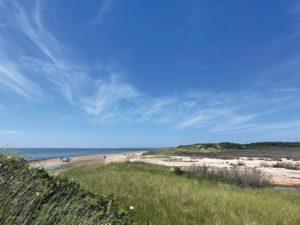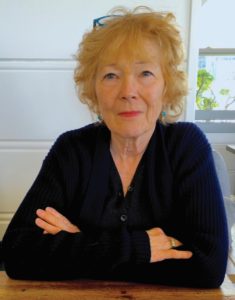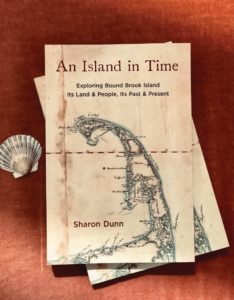In the same week that we came to live in a cottage halfway between Lombard and Paradise hollows, on the Wellfleet-Truro line, Christopher and I took a walk on Bound Brook Island.
Eager to get to know our new surroundings, we had consulted the topographical map that hung in the kitchen. To the southwest was a sort of hill, crisscrossed by footpaths that brought us to mesmerizing spots: overlooks, old oaks, hillocks carpeted with heath or moss, a few antique houses, and two decidedly modern ones. But where exactly is the “island,” we wondered.

On one of our first traipses, we came upon a small cemetery that got our imaginations spinning. Now we had more questions. Who was Mary Lombard, who was only 44 when she died in 1859? How was she connected to the hollow that we had quickly begun to think of as our own? Why was she buried here, in the middle of nowhere?
Poet Sharon Dunn had her own questions about this singular terrain when she arrived in the early 1990s. After she and her husband fell under the island’s spell, they moved into a nearly 200-year-old house on Bound Brook Island Road, where an encounter with their neighbor Jack Hall, the storied “Squire of Bound Brook Island,” fired Dunn’s curiosity.
In a slim but ambitious volume, Dunn delves deeply into the history of this place, which, she reveals, was at one time far from nowhere. Although we rarely see anyone on our walks here, An Island in Time: Exploring Bound Brook Island describes how the island hummed with its residents’ ocean-oriented commerce. And how it was in fact once an island.

Dunn’s across-the-cart-path neighbor soon became a friend. Hall passed along to her his deep love of the place where he had lived a rich and unconventional life — as a farmer, fisherman, artist, designer, builder, and resident historian. When Hall arrived on Bound Brook, there were only a few remaining houses. By the time he died in 2003 he had renovated some of those last houses and designed others that became modernist icons.
From that beginning, Dunn embarked on a years-long quest to write down Hall’s oral history. She compares the learning that led to the book to falling in love. The result is an examination of the geological, ecological, anthropological, economic, and social history of the area.
Dunn begins her account by delving into the geologic past and recounting the ways in which Bound Brook Island was sculpted by the pushing, pressing, scraping, and melting of the Laurentide ice sheet between 23,000 and 18,000 years ago.
From there, she shifts to the indigenous Punonakanit people of the Wampanoag federation, none of whom remained in the area after 1770. Subsequent chapters explore the European settlement that reached its zenith of 150 residents, living in 26 houses and having their own school, around 1850.
And an interesting lot they were. Using census records, newspaper archives, county deeds, town meeting notes, and historical maps, Dunn pieces together the stories of the families of shipbuilders, salt manufacturers, revivalist preachers, whalers, and fishermen.

Ultimately, the brook that formed the boundary of the island succumbed to a changing environment and silted up. Duck Harbor is now a beach; visitors have no sense of the navigable basin that once connected the Herring River to Cape Cod Bay.
Dunn describes how shoaling at the harbor that had provided anchorage for oceangoing vessels separated the community from the bay. And how, eventually, even smaller fishing vessels could not access the island. Deprived of their livelihoods starting around the turn of the 20th century, islanders disassembled (or “flaked”) their houses and moved them into town in Wellfleet, where many still stand, distinguished by signature five-light transoms over their entrances.
One aspect of Dunn’s book hints at her past as an editor at the literary journal AGNI. Her history is punctuated with poems inspired by her time on the island that reveal the transcendent sense of place the island holds for her. Like benches set along a path, Dunn’s poems provide a welcome resting place in the unfolding narrative. They give the reader a moment to pause.
Though almost 80 years old, Dunn is one of the most recent inhabitants of the island. But she ends her work with the imagined voice of one of its early residents in the poem The Old One. Aware of the risk of taking this kind of artistic license, Dunn said that she felt it was important to acknowledge the original stewards of the place. She had little choice other than to be imaginative in doing it: records amenable to research are sparse, as the native peoples have been largely written out of history. At least, she said, she could salute their status as the first people, who, in her mind’s eye, “keep walking the old trails, up and over.”
Arrowheads and ancient tools remain on a Bound Brook Island still returning to its natural state. Trails marking old cart paths still guide people across the land. A stone memorial to the now-gone school, cellar holes, and stands of privy lilacs are all reminders of the people who once lived here.
We still greet Mary Lombard and her family as we round the bend on our walks across a place we now know so much better for Dunn’s work. And now we know that Mary Paine Rich Lombard, who likely died of smallpox in 1859, was not buried in some lonely place in the middle of nowhere but within view of her family, who lived nearby.



